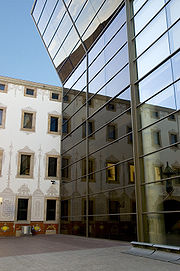
Centre de Cultura Contemporània de Barcelona
Encyclopedia


Barcelona
Barcelona is the second largest city in Spain after Madrid, and the capital of Catalonia, with a population of 1,621,537 within its administrative limits on a land area of...
.
Situated in the Raval district, the Centre’s core theme is the city
City
A city is a relatively large and permanent settlement. Although there is no agreement on how a city is distinguished from a town within general English language meanings, many cities have a particular administrative, legal, or historical status based on local law.For example, in the U.S...
and urban culture
Urban culture
Urban culture is the culture of towns and cities. In the United States, Urban culture may also sometimes be used as a euphemistic reference to contemporary African American culture.- African American culture :...
. Its success is based on quality, its rather eclectic approach, attention to a broad cross section of publics and the unique way it addresses issues with the aim of linking the academic world with creative processes and citizens in general.
The CCCB organizes and produces exhibitions, debates, festivals and concerts; programmes film cycles, courses and lectures; encourages creation using new technologies and languages, explores and promotes the ongoing fusion of languages and different genres, and takes in-house productions to other national and international arts centres, museums and institutions. The underlying aim of these activities is to generate debate, thinking and reflection on the theme of the city and public space, and other issues that define current affairs. The CCCB is also an open space for creators, associations and freelance programmers with whom it has forged links over the years.
The CCCB offers the public access to part of its holdings, a manifestation of its activities in the form of a multimedia archive comprising materials created by the Centre during its years of activity. A wide variety of materials (documents, publications, digital files, audiovisuals, etc.) on key themes of contemporary culture and society are available for consultation in the CCCB ARCHIVE, which is constantly updated.
Also available for public consultation is the Centre’s XCÈNTRIC ARCHIVE, a digital archive of experimental and documentary film, comprising over 700 titles related to its programme “Xcèntric. The CCCB’s Cinema”.
The CCCB is a public consortium created by the Diputació de Barcelona (Barcelona Provincial Council) and Barcelona City Council. The management body governing the consortium is the General Council, whose president is the President of the Diputació de Barcelona and whose vice-president is the city’s mayor. Josep Ramoneda is director general.
The building
The Centre has a floor area of 15,000 m², 4,000 of which are exhibition spaces. It also has an auditorium, a bookstore and various multiuse seminar and lecture rooms.The CCCB occupies part of the old Casa de Caritat almshouse, built in 1802 and serving this role until 1957. The remodelled premises are the work of the architects Helio Piñón and Albert Viaplana, and, in 1993, the project was awarded the FAD and Ciutat de Barcelona Architecture Prizes. The new project replaced the north wing, completing the original U-shaped layout with a 30-metre high prismatic volume, presenting a spectacular glazed façade that projects into the courtyard at the top. With its interplay of reflections, this new feature becomes a mirror of the surrounding rooftops and a prime lookout point over the city, as well as housing internal communications (halls, lifts and stairs).
In the spring of 2011, the CCCB expanded its premises with the incorporation of the former theatre
Theatre
Theatre is a collaborative form of fine art that uses live performers to present the experience of a real or imagined event before a live audience in a specific place. The performers may communicate this experience to the audience through combinations of gesture, speech, song, music or dance...
of the Casa de Caritat, which has recently been remodelled. The project, designed by Martinez Lapeña-Torres Arquitectos, SL, forms a basement-level connection with the current premises, in the Pati de les Dones courtyard, and addresses the old theatre, built in 1912 by the architect Josep Goday i Casals, and part of one of the 19th-century cloisters of the former Hospital de la Caritat.
A further 3,000 m2, designed to meet the functional needs of the Centre’s programme (multipurpose hall with capacity for 500 persons, a lecture room, and storage and maintenance space), will be added to the existing installations and programme in the course of the coming year.

